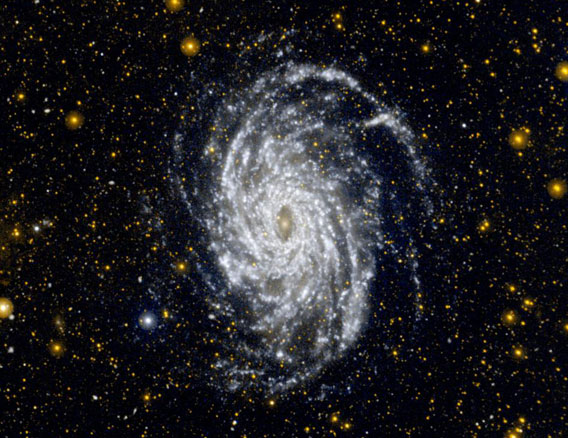Create a free profile to get unlimited access to exclusive videos, sweepstakes, and more!
An Ultraviolet Galaxy Hunter Closes Its Eye

On June 28, NASA flipped the switch for GALEX, shutting down the highly successful astronomical observatory. This was not unexpected; the mission had a fantastic 10-year run, and given NASAâs limited budget, the funding to operate it was needed elsewhere*. Itâs always sad to see a workhorse like this one put down, but it had a long and very successful life.
GALEXâthe Galaxy Evolution Explorerâobserved the sky in ultraviolet, a high-energy form of light. Young stars still embedded in their birth clouds pour out this kind of light copiously, and the primary goal of GALEX was to observe galaxies in the UV to determine the rate of star formation. By observing galaxies at all distances, from the local Universe to the farthest reaches of the cosmos, it would see them at different ages, allowing scientists to see how galaxies evolve over time. It was the only UV camera in space capable of doing this kind of survey.
Along the way it made some pretty amazing observations. Galaxies are lovely in the UV, but GALEX wasnât limited to looking just at them. It also took a peek at Mira, a red giant star just 400 light-years from Earth. The star is dying, shedding its outer layers while at the same time plowing at high speed through the thin material that lies between the stars themselves. The result is that the star looks like a comet with an extended tail, except that tail is 130 billion kilometers long. You can even see the bow shock wave, the arc in front (on the right) of the star as it rams through that interstellar material, compressing it.
It also looked at stars long dead: That picture above shows the Cygnus Loop, a vast structure created by the expanding debris of a long-ago exploded star, slamming into and sweeping up the gas around it. Located about 1,400 light-years away, the nebula is huge: 80 light-years across. Even at that tremendous distance, its apparent size is six to seven times that of the full Moon on the sky! The gas is compressed into tendrils and filaments hot enough to emit ultraviolet light, making it appear like an enormous jellyfish.
Lastly, I canât leave this without putting up that magnificent image of the Andromeda Galaxy, our nearest big spiral galaxy neighbor in the Universe. I wrote all about this image before, so you can get your fill (Phil?) of the science there. But itâs impossible not to be awed by the sprawling complexity of the spiral arms in this gorgeous galaxy, the site of the births of countless billions of stars. Because itâs so closeâabout 2.5 million light-years away, our back yard as galaxies goâAndromeda is one of the best-studied objects in the sky. In the fall itâs even visible to the naked eye, a faint smudge that belies its profound nature.
I never worked with GALEX directly, but Iâve worked extensively with a different space-based UV camera, and itâs hard to see one of its brethren turned off. But the data GALEX has taken will live on in archives that will be used by astronomers for many years. And I hope that in the future there will be more and more sophisticated observatories like GALEX yet to come.
*I think the fact that NASA has to make a choice to turn off functioning missions due to budget constraints is a national embarrassment. NASA costs us very, very little and gives us so, so much. See the bottom section of this post for my editorializing on this topic.


























